
"When Michelangelo created man,
He was anticipating cracks all along the ceiling."
--Dionisio Martinez, "Ash Wednesday",
History as a Second Language (1992)
Image courtesy of the Cappella Sistina
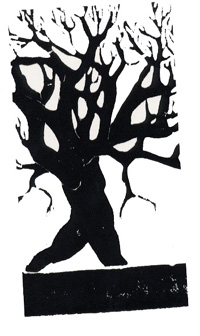 "I feel that there is much to be said for the Celtic belief that the souls of those whom we have lost are held captive in some inferior being, in an animal, in a plant, in some inanimate object, and thus effectively lost to us until the day (which to many never comes) when we happen to pass by a tree or to obtain possession of the object which forms their prison. Then they start and tremble, they call us by our name, and as soon as we have recognised their voice the spell is broken. Delivered by us, they have overcome death and return to share our life." --Marcel Proust, Remembrance of Things Past (1913)
"I feel that there is much to be said for the Celtic belief that the souls of those whom we have lost are held captive in some inferior being, in an animal, in a plant, in some inanimate object, and thus effectively lost to us until the day (which to many never comes) when we happen to pass by a tree or to obtain possession of the object which forms their prison. Then they start and tremble, they call us by our name, and as soon as we have recognised their voice the spell is broken. Delivered by us, they have overcome death and return to share our life." --Marcel Proust, Remembrance of Things Past (1913)PROVISIONAL NOTES ON MILIEU(X) AND ANTI-MILIEU(X)


I. GEORGES CANGUILHEM (1904-1995), "The Living and Its Milieu"*, Grey Room 03 (Spring 2001)
"The milieu provokes the organism to orient its own development." (p. 23) / Regarding Lucien Febvre (and his school), "In a human milieu, man is obviously subject to a determinism, but it is the determinism of artificial constructions." (p. 18) - "To live is to spread out; it is to organize a milieu starting from a central reference point that cannot itself be referred to without losing its original meaning." (p. 21) - "Living man takes from his relationship with man the scholar, in whose work ordinary perceptive experience finds itself contradicted and corrected, a sort of unconscious fatuousness that leads him to prefer his own milieu to that of other living things as having not only a different value, but a higher degree of reality." (p. 27) - milieu, "n. Environment, state of life, social surroundings. [F wd]", Oxford Pocket Dictionary (1924)
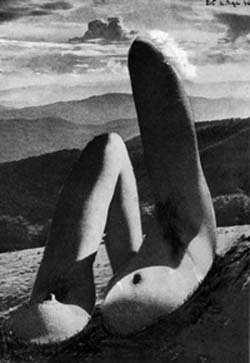 Image (left) - Karel Teige, Collage 316
Image (left) - Karel Teige, Collage 316*"Le Vivant et son milieu" was first presented in lecture form at the College Philosophique (Paris) in 1946-47. It was not published until 1952. Please note that this (1946-47) is the timeframe for Antonin Artaud's most strenuous works vis-à -vis 'effacing' the so-called subjectile (substrate) ... See Jacques Derrida & Paule Thévenin, The Secret Art of Antonin Artaud (Cambridge, MA: MIT Press, 1988)
Isaac Newton (1642-1727) - The milieu - "The fluid is the intermediary between two bodies; it is their milieu; and to the extent that it penetrates these bodies, they are situated within it." / Pascal (1623-62) - The milieu - "A median situation, a fluid of suspension, a life environment." - See: "Disproportion de l'Homme" - "Pascal knew that the cosmos had shattered into pieces [w/ Newtonian physics], but the eternal silence of infinite spaces frightened him. Man was no longer at the center (au milieu) of the world, but he is a milieu (a milieu between two infinites, a milieu between nothing and everything, a milieu between two extremes); the milieu is the state in which nature placed us; we are floating on a vast milieu; man is in proportion with the parts of the world; he relates to all that he knows: 'He needs a place to contain him, time in which to endure, movement to live, elements to make him up, heat and food to nourish him, air to breath ... and in the end, everything is his ally.'" / Lamarck (1744-1829) - The milieu - "Water, air, light" - "Lamarckism is not mechanism, and it would be inexact to call it finalism. In reality, it is naked vitalism." / Auguste Comte (1798-1857) - The milieu - "The sum total of outside circumstances necessary to the existence of each organism." - "The ambient system cannot modify the organism without the latter in turn exercising a corresponding influence." / Charles Darwin (1809-82) The milieu - "La concurrence vitale" - "The struggle for existence" / Alexander Humboldt (1769-1859) - The milieu - 'Geography' - See: Kosmos (1845-62) - "For in the beginning geography was for the Greeks the projection of the sky onto the earth, the coming together of earth and sky, a correspondence (geometry and cosmography) and a hierarchical correspondence (physics and astrology)." - "It is the theory of universal sympathy, a vitalist intuition of universal determinism, that gives its meaning to the geographical theory of the milieu."
If Canguilhem's review of the development of the concept of milieu echoes Bachelard's 'psychoanalysis of fire', it is not a coincidence. La Psychanalyse du Feu (Paris: Librairie Gallimard, 1938), a poeticized, 'surrationalist' reading/writing, follows the same trajectory through the positivist territory of modern science to a purely synthetical postulation of 'fire' as a quintessential sign for the spirit animating a singular human / natural milieu. To accomplish this 'turn', Bachelard privileges the sign of fire within Novalis' world, a transfigured milieu that reconnects human and cosmic milieux, a return to a cosmogonic eros also broached in the more abstruse work of Walter Benjamin.
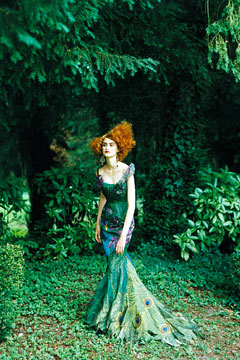 CANGUILHEM BIBLIOGRAPHY
CANGUILHEM BIBLIOGRAPHYCanguilhem, Georges (1904-1995), "The Living and Its Milieu", Grey Room 03 (Spring 2001), pp. 7-31 / _____________, The Normal and the Pathological (New York: Zone Books, 1989) / _____________, Vital Rationalist: Selected Writings from Georges Canguilhem (New York: Zone Books, 2000) / _____________, La connaissance de la vie [1re éd. 1952] (Paris: Vrin, 2E éd., 1975) / _____________, Idéologie et rationalité dans les science de la vie (Paris: Vrin, 1981) / _____________, Essais d'histoire et de philosophie des sciences (Paris: Vrin, 1968) / _____________, Le Normal et le Pathologique [1re éd. 1943] (Paris: PUF, 1966)
Image (left) - "Dress", John Galliano, for Dior Haute Couture, October 1997, Courtesy of Vogue (Peter Lindbergh photo)
For a thoroughly mesmerizing survey of the phantasmatic 'nature' of the contemporary fashion world, see Judith Clark (ed.), Spectres: When Fashion Turns Back (London: V&A Museum, 2005) - Cloth, 168 pages, ISBN 1-851-77456-4 - Exhibition catalogue for "Malign Muses: When Fashion Turns Back" (V&A, 2004 & Mode Museum, Antwerp, 2004-2005) / See also, Andrew Bolton (ed.), Wild: Fashion Untamed (New York: Metropolitan Museum of Art/Yale University Press, 2004) - Paper, 179 pages, ISBN 0-300-10638-6 - Catalogue for the Metropolitan Museum of Art (New York) exhibition, 2004
II. ANTONIN ARTAUD (1896-1948) - BRETON, RE ARTAUD BY WAY OF NOVALIS - "Each time I happen to recall -- nostalgically -- the surrealist rebellion as expressed in its original purity and intransigence, it is the personality of Antonin Artaud that stands out in dark magnificence, it is a certain intonation in his voice that injects specks of gold into his whispering voice ... [...] I know that Antonin Artaud saw, the way Rimbaud, as well as Novalis and Arnim before him, had spoken of seeing. It is of little consequence, ever since the publication of [Gérard de Nerval's] Aurélia [1855], that what was seen this way does not coincide with what is objectively visible. The real tragedy is that the society to which we are less and less honored to belong persists in making it an inexpiable crime to have gone over to the other side of the looking glass." --André Breton, "A Tribute to Antonin Artaud", in Free Rein, cited in Jacques Derrida and Paule Thévenin, The Secret Art of Antonin Artaud (Cambridge, MA: MIT Press, 1998) / More Artaud (including bibliography)...
ARTAUD'S 'SUBJECTILE', BY WAY OF DERRIDA - “The subjectile: itself between two places. It has two situations. As the support of a representation, it’s the subject which has become a gisant, spread out, stretched out, inert, neutral (ci-git). But it doesn’t fall out like this, if it is not abandoned to this downfall or this dejection, it can still be of interest for itself and not for its representation, for what it represents or for the representation it bears.” (p. 76) / “Neither object nor subject, neither screen nor projectile, the subjectile can become all that, stabilizing itself in a certain form or moving about in another.” (p. 77) / “[T]he subjectile is nothing, however, nothing but a solidified interval between above and below, visible and invisible, before and behind, this side and that.” (p.78) / Regarding Artaud’s work in both theatre and drawing/writing, Derrida looks (once again) into the essay/mirror “Mise en scène et la métaphysique” [1931], the critical essay in Théâtre et son double (The Theater and Its Double) that deals with Artaud’s confrontation with the painting Lot and His Daughters, by Lucas van Leyden, an approach to painting further explored in his writing about van Gogh: “The ‘subordination’ of the landscape, subject and object of the representation, belongs to what is represented on the subjectile, underlying the representation. Nevertheless, through a metonymy that precisely organizes the whole scene of the subjectile, the two surfaces are going to be substituted one for the other: in the work of Artaud and under his hand.” (p. 88) / Within this agonistic ‘negative’ dialectic (not this, not that), what moves in Artaud’s privileging of ‘expressivity’ is a concept of milieu (mise en scène) that also serves as a cipher for not-self (an older, archaic Self) which matches the extraordinary force of the sublime other (in a manner not dissimilar to the force of will privileged by the Romantics). Artaud is tiptoeing toward an encounter with the real real (he says, as well, that the way out is through the real to the surreal), a real real that dissolves boundaries and accesses that “dark force” (Spirit) that he also finds within himself (below all manner of interior discourse, mechanistic drives, displacements, dissociations, and dislocations he seems to situate in/within abject subjectivity). / Citations from "To Unsense the Subjectile", in Jacques Derrida and Paule Thévenin, The Secret Art of Antonin Artaud (Cambridge, MA: MIT Press, 1998), pp. 58-157
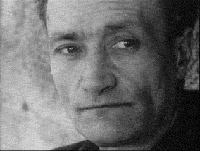 ARTAUD RE VAN GOGH - “So I shall not describe a painting of van Gogh after van Gogh, but I shall say that van Gogh is a painter because he recollected nature, because he reperspired it and made it sweat, because he squeezed onto his canvases in clusters, in monumental sheaves of color, the grinding of elements that occurs once in a hundred years, the awful elementary pressure of apostrophes, scratches, commas, and dashes which, after him, one can no longer believe that natural appearances are not made of. / And what an onslaught of repressed jostlings, ocular collisions taken from life, blinkings taken from nature, have the luminous currents of the forces which work on reality had to reserve before finally driven together and, as it were, hoisted onto the canvas, and accepted?” --Antonin Artaud, Antonin Artaud: Selected Writings (New York: Farrar, Straus and Giroux, 1976), p. 499, cited in Jacques Derrida and Paule Thévenin, The Secret Art of Antonin Artaud (Cambridge, MA: MIT Press, 1998), p.72 / “[T]hese sunflowers of bronzed gold are painted; they are painted as sunflowers and nothing more, but in order to understand a sunflower in nature, one must now go back to van Gogh.” / “Under the guise of representation he welded an air and enclosed within it a nerve, things which do not exist in nature, which are of a nature and an air more real than the air and nerve of real nature.” --Antonin Artaud, op. cit. (1976), p. 502, cited in Derrida and Thévenin, op. cit. (1998), p. 90
ARTAUD RE VAN GOGH - “So I shall not describe a painting of van Gogh after van Gogh, but I shall say that van Gogh is a painter because he recollected nature, because he reperspired it and made it sweat, because he squeezed onto his canvases in clusters, in monumental sheaves of color, the grinding of elements that occurs once in a hundred years, the awful elementary pressure of apostrophes, scratches, commas, and dashes which, after him, one can no longer believe that natural appearances are not made of. / And what an onslaught of repressed jostlings, ocular collisions taken from life, blinkings taken from nature, have the luminous currents of the forces which work on reality had to reserve before finally driven together and, as it were, hoisted onto the canvas, and accepted?” --Antonin Artaud, Antonin Artaud: Selected Writings (New York: Farrar, Straus and Giroux, 1976), p. 499, cited in Jacques Derrida and Paule Thévenin, The Secret Art of Antonin Artaud (Cambridge, MA: MIT Press, 1998), p.72 / “[T]hese sunflowers of bronzed gold are painted; they are painted as sunflowers and nothing more, but in order to understand a sunflower in nature, one must now go back to van Gogh.” / “Under the guise of representation he welded an air and enclosed within it a nerve, things which do not exist in nature, which are of a nature and an air more real than the air and nerve of real nature.” --Antonin Artaud, op. cit. (1976), p. 502, cited in Derrida and Thévenin, op. cit. (1998), p. 90III. BERGSONISME - Henri Bergson (1859-1941) - Matière et mémoire (1896), L'Évolution créatrice (1907) - "As Bergson declares, in his 1902 lectures at the Collège de France, now made available in the first issues of the Annales bergsoniennes, entitled 'The History and Concept of Time', it is an intuition of durée which generates and informs his philosophic vision. This institution took possession of Bergson's consciousness at Clermont-Ferrand in what may have been a shock of sensibility comparable to 'the road to Damascus'. As Gilles Deleuze would put it in his penetrating summations, for Bergson durée defines existence itself. On the one hand, there is the 'time' of the mathematician and physicist, of the chronometer without which science and technology would be impossible. On the other, there is 'duration', time as human awareness experiences it [...] The radicalism of Matière et mémoire consists in Bergson's ascription to durée not only of a psychological or illusory reality, but a phenomenal existence in the outside world." --George Steiner, "Mystic Master: Bergson's Lucid Life and Cloudy Grim Death", TLS (February 28, 2003) / Albert Brachet - La vie creation des formes (1927) / Henri Focillon (1881-1943) - La vies des formes (1934) - "Realms: Space, Matter, Mind, Time" / Neo-Vitalist Situationisme ... / Regarding William James' Essays in Radical Empiricism (1912)
IV. THE ANATOMY (AUTONOMY) OF FORM
re Henri Focillon / Provisional 'Field' Notes from The Life of Forms in Art / Vies des formes (1934) - Henri Focillon (1881-1943) / English edition, The Life of Forms in Art (New York: Zone Books, 1989)
 Notes from the Introduction by Jean Molino (1986) / "Form [...] 'sets up within history an immutable order,' an autonomous reality that presents itself as a 'fourth realm' added to the three realms of the physical world." (p. 11) /
"'The most attentive study of the most homogeneous milieu, of the most closely woven concatenation of circumstances, will not serve to give us the design of the towers of Laon.'" (p. 13) / "There exists, then, a world of artistic forms; but what is a form? The first move is, if not to define it, at least to see the model for it in contour or diagram, the shadow thrown by a body exposed to the sun, the play of cracks and fissures on the wall where Leonardo saw warriors and clouds take on outlines." (p. 16) / Karl Popper: First World (physical), Second World (subjective), Third World (symbolic) (p. 20) / "'[F]orm signifies only itself ...'" (p. 21) / Worringer-Wolfflin: psychodynamics of art / Panofsky-Warburg: iconography/iconology / Foucault: spasmodic histories and ruptures / "[F]orm and significance ..." (p. 21) / Signifier and signified - "Sign: index, sign, icon, symbol" / Artistic form is none of these but can become any of the four forms of sign ... (p. 21) / "The meaning of form is above all the rhythm of the body, the movement of the hand, the curve of the gesture. It is only at a second stage that the various levels of conceptual signification become articulated and attached to form." (p. 21) / See 'field' notes on sub-linguistic territories ... / "[F]orms are caught in a perpetual metamorphosis ..." (p. 26) / "'Rembrandt's sketches swarm across Rembrandt's paintings ...'" (p. 27) / "O memories! O horrible form of the hills!" Victor Hugo (p. 27)
Notes from the Introduction by Jean Molino (1986) / "Form [...] 'sets up within history an immutable order,' an autonomous reality that presents itself as a 'fourth realm' added to the three realms of the physical world." (p. 11) /
"'The most attentive study of the most homogeneous milieu, of the most closely woven concatenation of circumstances, will not serve to give us the design of the towers of Laon.'" (p. 13) / "There exists, then, a world of artistic forms; but what is a form? The first move is, if not to define it, at least to see the model for it in contour or diagram, the shadow thrown by a body exposed to the sun, the play of cracks and fissures on the wall where Leonardo saw warriors and clouds take on outlines." (p. 16) / Karl Popper: First World (physical), Second World (subjective), Third World (symbolic) (p. 20) / "'[F]orm signifies only itself ...'" (p. 21) / Worringer-Wolfflin: psychodynamics of art / Panofsky-Warburg: iconography/iconology / Foucault: spasmodic histories and ruptures / "[F]orm and significance ..." (p. 21) / Signifier and signified - "Sign: index, sign, icon, symbol" / Artistic form is none of these but can become any of the four forms of sign ... (p. 21) / "The meaning of form is above all the rhythm of the body, the movement of the hand, the curve of the gesture. It is only at a second stage that the various levels of conceptual signification become articulated and attached to form." (p. 21) / See 'field' notes on sub-linguistic territories ... / "[F]orms are caught in a perpetual metamorphosis ..." (p. 26) / "'Rembrandt's sketches swarm across Rembrandt's paintings ...'" (p. 27) / "O memories! O horrible form of the hills!" Victor Hugo (p. 27)Image (above, left) - Karel Teige, Collage 286
V. ENDNOTES / OUTTAKES
 SOME THINGS ABOUT 'THE THING' - Jane Bennett, The Enchantment of Modern Life: Attachments, Crossings, and Ethics (Princeton: Princeton University Press, 2001) - Paper, 224 pages, ISBN 0-691-08813-6 (Cloth, ISBN: 0-691-08812-8), "Perhaps the best way to begin to describe Bennett’s use of ‘enchantment’ is to note that she is really writing a story of anti-disenchantment. She takes the dominant interpretation of modernity, at least in social science, to be a narrative of disenchantment (with Max Weber’s theorizing providing a convenient paradigm which she discusses in detail.) Thus, the general secularizing of belief and culture which has taken place over the past several hundred years is characterized for her by two images, ‘The first is the image of modernity as disenchanted, that is to say, as a place of dearth and alienation (when compared to a golden age of community and cosmological coherency) or a place of reason, freedom, and control (when compared to a dark and confused premodernity).’ Her idea is that the characterization of the world as disenchanted may “discourage affective attachment to the world” and be destructive to the possibility of ethical life." Review, Stanley Bates (Notre Dame Philosophical Reviews, 2002) / See also, Jane Bennett, "The Force of Things: Steps toward an Ecology of Matter", Political Theory 32 (2004), pp. 347-372 / "On the one hand, then, the thing baldly encountered. On the other, some thing not quite apprehended. Could you clarify this matter of things by starting again and imagining them, first, as the amorphousness out of which objects are materialized by the (ap)perceiving subject, the anterior physicality of the physical world emerging, perhaps, as an aftereffect of the mutual constitution of subject and object, a retroprojection? You could imagine things, second, as what is excessive in objects, as what exceeds their mere materialization as objects or their mere utilization as objects--their force as a sensuous presence or as a metaphysical presence, the magic by which objects become values, fetishes, idols, and totems. Temporalized as the before and after of the object, thingness amounts to a latency (the not yet formed or the not yet formable) and to an excess (what remains physically or metaphysically irreducible to objects). But this temporality obscures the all-at-onceness, the simultaneity, the object/thing dialectic and the fact that, all at once, the thing seems to name the object just as it is even as it names some thing else." Bill Brown, "Thing Theory", Critical Inquiry, Vol. 28. No. 1 (Fall 2001) - For Critical Theory, cliquez ici / Austin Harrington, “New German Aesthetic Theory: Martin Seel's Art of Diremption”, Radical Philosophy 109 (September-October 2001), "Philosophy and art converge in their truth content: The progressive self-unfolding truth of the artwork is none other than the truth of the philosophical concept.... The truth content of artworks is not what they mean but rather what decides whether the work in itself is true or false, and this truth of the work in-itself is commensurable to philosophical interpretation and coincides ... with the idea of philosophical truth." (Adorno)
SOME THINGS ABOUT 'THE THING' - Jane Bennett, The Enchantment of Modern Life: Attachments, Crossings, and Ethics (Princeton: Princeton University Press, 2001) - Paper, 224 pages, ISBN 0-691-08813-6 (Cloth, ISBN: 0-691-08812-8), "Perhaps the best way to begin to describe Bennett’s use of ‘enchantment’ is to note that she is really writing a story of anti-disenchantment. She takes the dominant interpretation of modernity, at least in social science, to be a narrative of disenchantment (with Max Weber’s theorizing providing a convenient paradigm which she discusses in detail.) Thus, the general secularizing of belief and culture which has taken place over the past several hundred years is characterized for her by two images, ‘The first is the image of modernity as disenchanted, that is to say, as a place of dearth and alienation (when compared to a golden age of community and cosmological coherency) or a place of reason, freedom, and control (when compared to a dark and confused premodernity).’ Her idea is that the characterization of the world as disenchanted may “discourage affective attachment to the world” and be destructive to the possibility of ethical life." Review, Stanley Bates (Notre Dame Philosophical Reviews, 2002) / See also, Jane Bennett, "The Force of Things: Steps toward an Ecology of Matter", Political Theory 32 (2004), pp. 347-372 / "On the one hand, then, the thing baldly encountered. On the other, some thing not quite apprehended. Could you clarify this matter of things by starting again and imagining them, first, as the amorphousness out of which objects are materialized by the (ap)perceiving subject, the anterior physicality of the physical world emerging, perhaps, as an aftereffect of the mutual constitution of subject and object, a retroprojection? You could imagine things, second, as what is excessive in objects, as what exceeds their mere materialization as objects or their mere utilization as objects--their force as a sensuous presence or as a metaphysical presence, the magic by which objects become values, fetishes, idols, and totems. Temporalized as the before and after of the object, thingness amounts to a latency (the not yet formed or the not yet formable) and to an excess (what remains physically or metaphysically irreducible to objects). But this temporality obscures the all-at-onceness, the simultaneity, the object/thing dialectic and the fact that, all at once, the thing seems to name the object just as it is even as it names some thing else." Bill Brown, "Thing Theory", Critical Inquiry, Vol. 28. No. 1 (Fall 2001) - For Critical Theory, cliquez ici / Austin Harrington, “New German Aesthetic Theory: Martin Seel's Art of Diremption”, Radical Philosophy 109 (September-October 2001), "Philosophy and art converge in their truth content: The progressive self-unfolding truth of the artwork is none other than the truth of the philosophical concept.... The truth content of artworks is not what they mean but rather what decides whether the work in itself is true or false, and this truth of the work in-itself is commensurable to philosophical interpretation and coincides ... with the idea of philosophical truth." (Adorno)*CAILLOIS, ETCETERA - Regarding a performative, pseudo-deranged take on milieu and anti-milieu, see "Roger Caillois's infamous 1935 essay 'Mimicry and Legendary Psychasthenia' [1935], in which the dissident Surrealist suggested that the phenomenon of insect camouflage should be compared to a type of schizophrenic psychic condition characterized as a 'depersonalization by assimilation to space': an entropic loss of distinctions, of ego boundaries, of any bodily sense of inside and outside." (Artforum, 02/00) / Caillois' essay was re-published in October 31 (Winter 1984), trans. John Shepley, pp. 17-32
DANTE FERRETTI @ INSTITUTO DI ITALIANO DI CULTURA (NEW YORK) - On the occasion of the publication of Gabriele Lucci (ed.), Ferretti: L’Arte della Scenografia (Milan: Electa, 2005), prepared and co-published by Accademia [...] dell’Immagine (L’Aquila) - Anecdotal Evidence (paraphrases) per mise en scène as cinematic ‘Other’ - Ferretti: Six films each w/ Pasolini, Fellini, Scorsese … On Pasolini: "Cinema (almost) like painting ... Very graphic ... As cultural filter [cipher] ..." ... On Fellini: "Art direction as dreamwork ... Expansive (grande) ... Not to be afraid of mistakes ... All films about ‘himself’ (dreams and nightmares) ..." ... On process: "Large ‘models’ (drawings 2 meters long) ... To 'scare' (impress) the director early on ... To suggest what is not yet present (thought of) ... Realistic (plausible) images / sketches of ‘environments’ in which characters can move and interact ..." ... On iconography: "No constants ... Mutable influences (drawn from research), or ‘The ship sails on’ into an artificial sea ... Immersion and mistakes ... All toward the production of an innate sensibility for the film ... For example, Fellini’s ‘Wrecking ball, puppy, and crumbling wall ..." (GK 03/07/05) / For the ineluctable élan of the cinematic-photographic image (or, thinking in images), see Books / Texts (Yellow Pages) ...
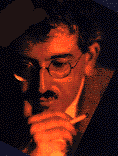 RADICAL EMPIRICISM - Apropos of present-day, 'neo-Bergsonian' radical empiricism, cliquez ici (Samizdat) ...
RADICAL EMPIRICISM - Apropos of present-day, 'neo-Bergsonian' radical empiricism, cliquez ici (Samizdat) ...MILIEU THEORETICIANS - "If we reflect how long the belief in disguises survived -- how farce throughout the ages, Shakespeare's high comedy, and even the detective story of the late nineteenth century found it quite unproblematic to work with the confusions that result from disguises -- it must be a matter of considerable astonishment to see how reluctant people are to accept such devices in more recent times. When it comes to disguises, they refuse to see the joke, and in the modern novel such mistaken identities are frowned on. Yet this dogged insistence on the unmistakable, unique singularity of the body comes at precisely the moment when philanthropists, the disciples of Proust, and psychoanalysts assure us that all possibilities dwell within each of us, and that nothing could be more out-of-date and philistine than the belief in the unity of the personality. What can be behind this?" Walter Benjamin (1929)
WHAT GIVES & WHAT TAKES? - Andrew Bolton (ed.), Wild: Fashion Untamed (New Haven: Yale University Press, 2004) - Exhibition catalogue, Metropolitan Museum of Art / THE FASHION FUSION THING - Linda Fargo, Dreams Through the Glass: Windows from Bergdorf Goodman (New York: Assouline, 2003) - Cloth, 159 pages, ISBN 2-843-23522-7 / Michèle Gazier et alia, Les Vitrines Hermès: Contes Nomades de Leila Menchari (Paris?: Editions Imprimerie Nationale, 1999) - Cloth, 309 pages, ISBN 2-743-30329-8 / Claude D'Anthenaise, Janine Janet: Métamorphoses (Paris: Editions Norma/Musée de la Chasse et de la Nature, 2003) - Cloth, 127 pages, ISBN 2-909-28379-8 - Catalogue for the exhibition (April 30 through September 21, 2003)
THE PRESENT-PRESENT - "Between the vast future of the thing-to-be-done, which is our 'duty', and the immense past of the 'done' thing, which is our presumedly 'achieved' duty, there must be an elusive and extremely short occurrence, as dazzling as happiness, that can be called the being-done, that is being done." Vladimir Jankélévitch
THE THING WITHIN THINGS - "The true sense of every judgement, e.g. that A is B can only be this: that which is A is that which is B, or that which is A and that which is B is the same/one (einerlei). Thus even the simple concept is grounded in a duality: A in this judgement is not A, but something = x, which is A; thus B is not B, but something = x, which is B; and not this (not A and B for itself) but the x that is A and the X that is B is the same, namely the same x. In the proposition cited three positions are really contained, first A is = x, second B is = x, and only out of this follows the third, A and B are one and the same, both namely x … the properly understood law of contradiction really only says that the same cannot be as the same something and also the opposite thereof, but this does not prevent the same, which is A, being able, as an other, to be not A." F W J von Schelling, Sämmtliche Werke, K F A Schelling (ed.), Vol. 7 (Stuttgart: Cotta, 1856-61), p. 425; trans. Andrew Bowie in Schelling and Modern European Philosophy, p. 122. Bowie deploys this explication of the ground that underwrites all predication in his discussion of Schelling’s Ages of the World (Die Weltalter), a work that struggles to show how, in a meta-historical manner, something can arrive out of nothing.
TANGENT 2 - Eliasson's Virtual Weather (Samizdat)
TANGENT 3 - German Idealism Calling (Yellow Pages)
TANGENT 4 - Lucretius' De rerum natura (Samizdat)
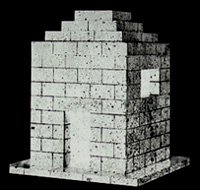 LAST RITES / THE ANTI-MILIEU - "M. de Lemarck distinguished between nature and life. In his eyes, nature was stone and ash, a granite tomb, death. Life came into play only as a strange and singularly productive accident, a prolonged struggle with here or there more or less balance or success, but always finally defeated in the end; cold motionlessness reigned afterwards as before." --Charles Sainte-Beuve, Volupté (1834), cited in Georges Canguilhem, "The Living and Its Milieu", Grey Room 03 (Spring 2001), p. 30 (Note 12) / "Somewhere and nowhere in every Derridean topography is a secret place, a crypt whose coordinates cannot be plotted. This place exceeds any ordinary topographical placement." J. H. Miller, Topographies (Stanford, CA: Stanford University Press, 1995), p. 296, cited in Paivi Kymäläinen, "Topologies of Becoming: Deferred Presence in Writing", Space & Culture, Vol 6, No. 3 (August 2003), p. 245 (Epigraph) ...
LAST RITES / THE ANTI-MILIEU - "M. de Lemarck distinguished between nature and life. In his eyes, nature was stone and ash, a granite tomb, death. Life came into play only as a strange and singularly productive accident, a prolonged struggle with here or there more or less balance or success, but always finally defeated in the end; cold motionlessness reigned afterwards as before." --Charles Sainte-Beuve, Volupté (1834), cited in Georges Canguilhem, "The Living and Its Milieu", Grey Room 03 (Spring 2001), p. 30 (Note 12) / "Somewhere and nowhere in every Derridean topography is a secret place, a crypt whose coordinates cannot be plotted. This place exceeds any ordinary topographical placement." J. H. Miller, Topographies (Stanford, CA: Stanford University Press, 1995), p. 296, cited in Paivi Kymäläinen, "Topologies of Becoming: Deferred Presence in Writing", Space & Culture, Vol 6, No. 3 (August 2003), p. 245 (Epigraph) ...Image (above, left) - Tomb for Arnold Hauser (1892-1978), Adolf Loos (1921)